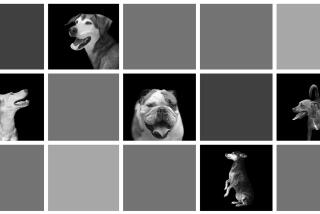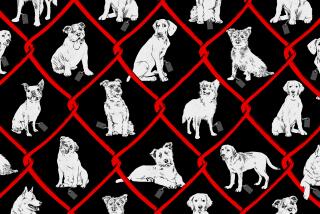MICHAEL WALDMAN : The Hounds of A & E
- Share via
Woof, woof ... wolf! A&E;’s six-part series “Dogs” begins, naturally, with their howling forefathers. But once a sense of ancient lineage is established, the cable channel explores all manner of canine, past and present.
From purebreds--and the lengths some of their blueblooded best friends will go to breed them--to family mutts to why owning a dog is a crime in China and a status symbol in Japan, the series gets more mileage out of the subject than Lassie’s return home.
And why shouldn’t it? The appeal of the series, which was 18 months in the making, is universal. After telling us why we’re so attached to dogs in the first part, the second installment, “Fame and Fortune,” gets in the doghouse with Rin Tin Tin, Benji and, of course, everyone’s favorite collie. Plus, trips to poodle parlors and New York’s popular Westminster Dog Show.
The heroic, often “sixth sense,” nature of canines is certified in Part 3, as we meet Ribbon, a dog who predicts her owner’s epileptic seizures and has virtually saved her life. Part 4 poses the question of, “Do dogs possess healing qualities,” and travels worldwide in search of that power.
By the end of Part 6, after examining the use of dogs in advertising and how they relate to social standing, the series hopes to answer why humans continue to be fascinated with, frightened by, and in love with their pooches.
Dog fancier Penny Krebbs spoke with executive producer Michael Waldman, by phone from London, about one of her favorite subjects.
Who do you think benefits the most from the relationship between dog and man?
I think both equally benefit. I think that dogs benefit because without man they would not have been created from the wolf. Whether that is in their interest or not, it is rather difficult for any human to say. But concluding from statistical data, they would not exist in such numbers now. A contract was made 20,000 years ago in which man gave wolf food and protection and in exchange the wolf made a bargain with mankind that he would become domesticated and give humans the benefit of protection, affection and companionship. In that way, I think humans have benefited hugely and continue to do so.
Do you think the human fascination with dogs is increasing or decreasing?
I think it is increasing. I think that the relationship started years ago with protection, hunting and companionship. What is so fascinating is that the bonding relationship continues. We filmed relationships of a fisherman in Greenland, a huntsman in New Guinea and dog owners in America, and what we found was that in societies where the necessity for dogs is less (such as Western society), there is a deeper affection for the animal. What I think is interesting is that the relationship is so deep because there is only a sentimental attachment rather than an absolute necessity for the dog. Perhaps the fisherman and the huntsman have feelings for their dogs, but it is less intense.
One recurring idea in your documentary is that dogs are pack animals and therefore need a leader. Can you elaborate on this?
Approximately 20,000 years ago, early humans enticed wolves, presumably with food, into their caves. The way in which they managed to make the wolves nonaggressive toward them is their understanding of the hierarchies that are based on the pack system with a pack leader. By interposing himself as pack leader, man was able to domesticate the wolf. This original relationship should also be present in the daily relationship between the dog owner and the dog. When the relationship goes wrong, it is usually because there is a lack of discipline. The dog actually needs to know who is master or mistress and when that relationship isn’t made clear, all sorts of problems arise.
What was one of your most favorite moments while making this documentary?
Our journey across the frozen ocean in Greenland, driven by a team of beautiful huskies. We followed our fisherman and saw the way in which he had utter control over this living vehicle, this team of 12. The fisherman would drive that team like a racing-car driver would drive a finely tuned racing car. It was precision control and an emotional relationship in harmony.
While researching this subject, did you come across any surprising discoveries?
Yes. The extraordinary ability of dogs that track their masters over huge distances. We filmed bloodhounds in Upstate New York near Albany who have an amazing track record of rescuing people who are lost. The way they do it, apparently, is with their sense of smell.
Has your appreciation for dogs changed after making this documentary?
I started off not as a dog lover but frankly indifferent to dogs. I was quite fond of other people’s dogs, but I never had the desire to have one myself. In fact, that made me good casting for this project because it was designed not only to be of interest for dog lovers from all over the world but for people like me who didn’t think themselves as that interested in dogs and were, in a sense, bemused by their friends who were dog lovers and the degree of their affection and closeness to their dogs.
“Dogs” airs Sunday-Thursday at 5 and 9 p.m. on A & E.
More to Read
The complete guide to home viewing
Get Screen Gab for everything about the TV shows and streaming movies everyone’s talking about.
You may occasionally receive promotional content from the Los Angeles Times.






